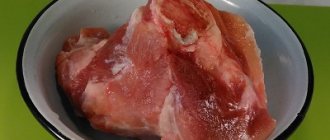It’s rare that an owner offers his dog pure meat: it’s expensive and not very healthy. By-products are usually mixed with porridge and vegetables. But a dog’s stomach can’t digest just any porridge: some cereals cause pain and discomfort.
Among these harmful dishes is also barley, which is useful, according to many. What is the harm, is it worth offering your dog pearl barley and how to prepare it correctly, we will consider in the article.
The benefits of cereals
Pearl barley is a type of barley grain processed in a certain way (by grinding). Hence the name, consonant with “pearl” - pearls, which it looks a little like.
A close “relative” of pearl barley is barley groats, which is also made from barley, but chopped and not processed. It has the following advantages:
- high in calories, which allows the animal to easily get enough. And its ability to increase 5 times during cooking will be appreciated by owners who want to reduce the cost of feeding their pet;
- rich in proteins, vitamins, micro and macroelements. Contains magnesium, potassium, phosphorus and iron. All this gives the dog strength and strengthens the immune system, allowing the development of muscle mass;
- a good source of fiber, which is extremely important in animal diets. In small doses it improves digestion;
- This is a rather coarse grain that makes the stomach “work” to digest it. That is why some experts recommend including it in the animal’s diet without fail;
- due to its mucilaginous properties, it is a good means of combating diarrhea.
Oats
Oats and rolled oats should not be confused. Oats are whole grains, while rolled oats are flattened grains. However, both cereals are very useful for your pet. They contain vitamins A, B, E, PP, minerals (calcium, potassium, magnesium, sodium, etc.), vegetable proteins, amino acids, fats.
Diet porridge is an indispensable product for normalizing digestion after an illness accompanied by vomiting and diarrhea, or prolonged fasting. Gluten delicately envelops the intestines and walls of the digestive tract, and has a beneficial effect on the stomach and pancreas during inflammation. Oatmeal and jelly are always recommended by nutritionists for animals with gastritis and enteritis.
Do not forget: oatmeal can cause allergies and digestive upset. If you are giving oatmeal for the first time, add it in small quantities to the main dish to check whether it will become an allergen for your pet, and observe for a day. If your dog does not have an allergic reaction to oatmeal, include it in the diet, but do not overuse it.
It is advisable to give preference to oats other than oatmeal. It takes longer to cook, but it contains more nutrients. To prepare the grains, soak them in cold water for 2-3 hours, then boil them without adding salt. With soaking, the cereal will cook in 40-50 minutes.
Why can't you feed it?
The main disadvantage of pearl barley is that many dogs are unable to digest it.
In the best case, it will come out of the stomach exactly in the form in which it got there - whole grains. Diarrhea will begin, the dog will defecate near the bowl, unable to bear it.
In the worst case, pearl barley that is not digested in the stomach will cause constipation in the dog. A side, but extremely unpleasant consequence will be refusal to eat: unprocessed food in the stomach will create a feeling of false satiety and kill your appetite.
Regularly feeding a dog, especially an elderly one or one who is simply sedentary, with pearl barley porridge is fraught with rapid obesity. Gaining excess weight will lead to other health problems.
Finally, pearl barley is a common allergen. In this case, after a couple of meals the animal will begin to itch, the skin under the fur will become bright pink, bald spots will appear, and in more severe stages, otitis media will develop and tearing will begin.
How and with what to give?
Barley should be included in the diet occasionally, alternating with other, more easily digestible cereals: rice, buckwheat and oatmeal. The best option is 1, maximum 2 times a week.
Barley should make up no more than 1/3 of the daily diet, mixed with meat and boiled vegetables. For better digestibility, it is cooked in beef broth.
If a dog loves pearl barley, then it will be willing to eat it, and it is important to calculate the serving size based on the weight of the animal in order to prevent overfeeding.
How to cook porridge?
Dogs usually eat pearl barley with pleasure, but to please your pet, you should try to cook it as appetizing as possible.
Recipe
Here's a sample recipe:
- Prepare the broth. It is best to cook it on the bones, but then throw away the bones and do not give it to your pet. The broth is not very fatty and is filtered.
- The cereal is washed.
- Barley is poured into a pan with boiling broth. The liquid should be left two fingers more from the level at which the cereal is in the pan.
- After boiling again, the heat is reduced and the pan is covered with a lid. Cook until fully cooked for about 2 hours; periodically you need to check to see if the water has boiled away. In the middle of cooking, you can salt the porridge - a little, literally on the tip of a knife.
- Five minutes before the porridge is ready, add meat and vegetables. There is also an option in which the meat and vegetables are not boiled, but placed raw in the porridge, but here it all depends on the preferences of the animal. The main rule is not to mix raw meat and cooked vegetables, or vice versa. At the very end of cooking, add herbs (parsley, dill, even nettles, dandelion leaves if desired).
Tip : you can beat a raw chicken egg into the porridge, but you should give it no more than once a week.
How long should you cook?
Barley is a slow-cooking porridge, so you need to prepare it in advance. Usually porridge from this cereal is cooked for about two hours; if undercooked it will be tough and tasteless.
The cooking time partly depends on the variety: coarse grains take longer to cook, fine grains with almost round grains cook faster. The shelf life of the cereal also plays a role: last year’s pearl barley takes longer to cook than this year’s pearl barley. Therefore, when purchasing cereal, it is worth looking at the packaging date.
There is a secret that allows you to cook pearl barley porridge faster, literally in half an hour. To do this, you need to pre-soak it.
This is done as follows: the pearl barley is washed and filled with cold water in the proportion of 1 cup of cereal per 1 liter of water. It is left in this form for about five hours; it is most convenient to do this at night.
During this time, the cereal will absorb a lot of water; the remainder must be drained. The pearl barley will swell and become easy to cook; cooking time will take about 30 minutes.
With milk or water?
Pearl barley with milk is perfect for puppies if they are fed this porridge. For an adult dog, it is better to boil the cereal in water, since many animals develop lactose intolerance with age. The best option would be to cook it in beef broth - this way it is easier to digest and seems more satisfying to the animal.
Can dogs have barley?
A well-chosen diet guarantees the dog’s well-being and the absence of stomach problems. Among existing cereals, there is a lot of controversy about pearl barley porridge. Some claim that you can’t feed it to your pets, while others think it’s healthy. In fact, whether dogs can have barley largely depends on the method of preparation and individual factors.
The benefits of cereals
The nutritional value of cereals proves that it is beneficial for people and animals. Pearl barley retains the valuable properties of barley, the grain on which it is produced. Barley is known as a “cleanser” of the body; it helps remove toxins and other debris.
Acting as animal feed, pearl barley is also valuable for various properties:
- high calorie content, which allows the pet to feel full;
- the product contains many useful microelements, vitamins: potassium, phosphorus, iron;
- improves digestion processes due to its fiber content;
- strengthens the immune system.
If you cook pearl barley correctly, it increases in size five times. This advantage is especially valuable for owners of large dogs, whose feeding can be expensive.
Why can't you feed it?
The dog's body sometimes cannot digest porridge. The main reason why pearl barley is harmful is its inability to be quickly absorbed. This is dangerous for representatives of breeds characterized by an inactive lifestyle, accustomed to lying down and sleeping after eating.
In other cases, the cereal will simply exit the body in its original form - undigested large grains. Barley is useful for dogs only when they are able to completely digest it.
Cereals can occasionally be present in the diet, then the animal will receive the maximum possible value of the product.
You should not give pearl barley to small toy dogs. Their internal organs, including the digestive system, are small in size. Barley, leaving the body as grains, can cause constipation, problems with stool, and disruptions in the digestive system. When deciding whether or not to feed your pet barley, you need to take into account the dog’s weight. The high calorie content of cereals can cause obesity and related diseases.
How to cook porridge - recipe
The standard recipe for cooking porridge is simple:
- Let's prepare the base. Porridge can be prepared with milk or water, but animals especially like it with broth. Any bones are suitable for its preparation; after removing them from the container, the broth must be strained. Water and milk are simply brought to a boil.
- We rinse the cereal under running water several times, add it to a container with water, milk, and broth. The proportion is taken as standard: the liquid should be two fingers above the level of the porridge.
- We wait until the liquid boils again, reduce the heat to minimum, and cook until tender. Barley needs to be cooked for a long time - one and a half to two hours. It is necessary to open the lid periodically to check if any liquid remains. If the proportion is calculated correctly and the heat is low, it is usually enough; if necessary, you can add water.
To cook porridge faster, you can pre-soak the cereal; some people do this in the evening. Then the cooking time takes about half an hour.
What to give with
Porridge alone will not satisfy your pet’s hunger. When choosing an addition to a dish, it is necessary to take into account the characteristics of the breed; representatives of each have individual feeding recommendations. It is usually recommended to give porridge along with vegetables and meat. These products can be added raw or cooked, depending on the preferences of the animal and the diet allowed for the breed.
It is better to add vegetables and meat 5-10 minutes before turning off the heat. Then 30 min. you need to wait, leaving the container closed. Some people find it convenient to prepare a multi-component dish based on pearl barley: while the porridge is cooking, the vegetables are stewed along with the meat. Then everything is mixed together.
The dietary option involves adding 1 egg to the barley; it does not need to be boiled separately, just beat it in 10 minutes before turning it off.
Pregnant or breastfeeding
Pearl barley does not play a significant role in the diet of pregnant bitches. You can give it, but a little at a time, given that the dog during this period needs food high in protein, since it is the main building material.
This cereal promotes weight gain, and overly fat animals have a difficult birth, so it is better to reduce the amount of cereal products during this period.
A nursing dog can eat pearl barley in the same quantities as before pregnancy.
Place in the diet
Experienced dog breeders recommend offering your pet pearl barley no more than once or twice a week. It can be given to adult and healthy dogs.
Feeding puppies this porridge is strictly prohibited. A growing body constantly needs nutrients for normal development. Therefore, giving poorly digestible food simply for the sake of “filling the stomach” is simply dangerous. In addition, in puppies it can cause bloating and other serious digestive problems, primarily constipation.
For the last reason, you should not give pearl barley to older dogs, especially if they already have problems with the digestive system. Such animals need specialized feed. The veterinarian will give the necessary recommendations depending on the breed and condition of the dog. It should be easily digestible food rich in minerals.
It is also not advisable to give this porridge to pregnant and lactating bitches. During this period, on the contrary, specialized nutrition with high nutritional value is necessary. You can purchase ready-made complete food for pregnant and lactating dogs.
If you feed “natural”, you should prepare the diet especially carefully, ideally under the supervision of a veterinarian. In this case, it is necessary to take into account the condition, age of the animal, and the course of pregnancy.
If you fed your pet, even a puppy, pearl barley porridge, there is nothing wrong with that. Most likely, the cereal will simply come out unchanged; you should not be afraid of this. One-time feeding will not lead to any negative consequences if the dog is completely healthy. But do not overuse this diet.
In case of an allergic reaction or constipation, monitor the animal’s condition. You may need to see a veterinarian.
Breed exceptions
There is no specific ban on pearl barley for any breed. But breeds with a weak stomach, prone to digestive problems, will perceive this porridge worse than others. According to statistics, dogs of small and miniature breeds, for example, toy terriers, Chinese crested dogs, chihuahuas and others, are prone to sensitive digestion.
Problems are especially common in Maltese, Yorkshire terriers and, strange as it may sound, in German shepherds. When giving pearl barley to these breeds, special care should be taken.
Contraindications
As we have already said, it is extremely undesirable to give pearl barley to lactating and pregnant bitches, puppies, elderly, sick, weakened animals.
Dogs should not barley if they have digestive problems. Some breeds should be given such porridge with extreme caution - for example, toy terriers, Chinese crested dogs, and most other decorative breeds have sensitive digestion; “heavy” porridge can cause problems for them.
And one more important point. Barley can cause an allergic reaction in dogs.
Therefore, it must be introduced into the diet carefully, gradually (especially for breeds prone to allergies). Give the animal a very small taste first. Only in the absence of negative reactions and bloating can you feed the dog barley next time.
Whether to give dogs pearl barley is up to each owner to decide for himself. Pearl barley porridge is not healthy for dogs, but usually there is no harm from it. Some owners of both purebred and mongrel dogs feed their pets this porridge regularly and assure that the animals are delighted with it. The main thing is to know when to stop and not make it the basis of your diet.
The majority of dogs are kept on a natural diet, which means preparing porridge with meat and vegetables. Cereals are undoubtedly a healthy product, but their “natural” value depends on the method of processing the raw materials. A dog’s diet requires strict selection of products, a balance between weight and energy value. Let's figure out what cereals can be given to dogs and whether grains can be harmful.
Note! Many breeders have a question about whether it is necessary to salt the dog’s food - it is definitely necessary, but after cooking. A low-salt diet is recommended for animals prone to urolithiasis.
What to do if things get bad?
If a dog has eaten pearl barley and feels sick, this may be due to the following.
Allergy. If, after introducing porridge into the diet, the animal begins to itch frequently, irritation and bald spots appear on the skin - it is most likely an allergy. In this situation, the dog needs to be shown to a veterinarian to accurately determine the allergen. The doctor may prescribe antihistamines. Barley will have to be completely excluded from the dog’s menu.
Diarrhea. It will not be difficult to recognize this problem: the pearl barley will come out of the dog’s stomach almost in its original form. This type of diarrhea can be treated at home. It is enough to give activated carbon (1 tablet per 10 kg of animal), skip several feedings and provide access to water to avoid dehydration.
Tinctures of burnet or serpentine also have a beneficial effect - they have an astringent effect. The optimal diet for the next few days is rice porridge and fermented milk products, fatty and heavy foods are unacceptable.
Constipation. The opposite effect of diarrhea after barley is also possible. In this situation, the dog will become lethargic and refuse food. She will make significant efforts to empty her bowels, “push”, but to no avail.
Helping your pet is easy: just add a couple of tablespoons of vegetable or castor oil to the food (1-3, depending on the size of the animal). It's worth trying to feed prunes. You can also purchase a special laxative for dogs for these purposes - it is available in veterinary pharmacies without a prescription.
What to replace or supplement with?
Dogs digest buckwheat and rice porridge best; they are also allowed to offer oatmeal and, occasionally, semolina. It is best to give pearl barley in smaller quantities than rice and buckwheat.
Millet and wheat porridge can be a replacement option for it - they are not recommended for animals, but a number of dog breeders give them without problems.
Another option for pearl barley is mixing it with other cereals. But it is important to ensure that it is completely boiled, because its cooking time is longer than that of other cereals.











